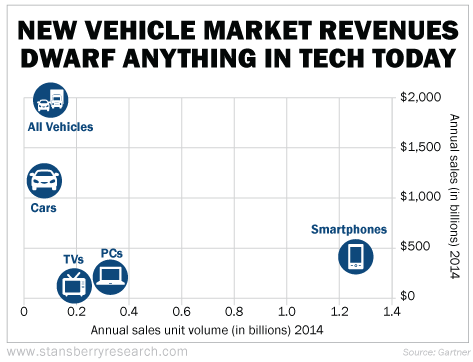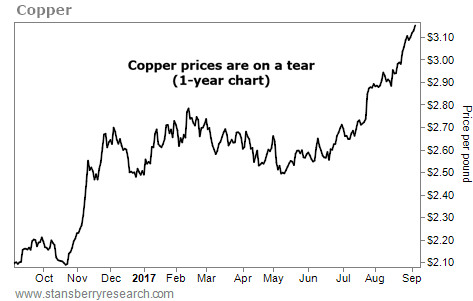| Home | About Us | Resources | Archive | Free Reports | Market Window |
This Technology Will Upend the Entire Automotive IndustryBy
Friday, September 8, 2017
Self-driving technology is about to completely upend the global automotive industry, which shipped 73.9 million vehicles in 2015.
That represents a more than $2 trillion market. And that's just the beginning...
As you can see in the chart below, the $2 trillion market for vehicles is multiples larger than the consumer market for televisions, personal computers, or smartphones...
 Now, you might think that self-driving cars won't be here until far off in the future. I wouldn't blame you, either. In a Wall Street Journal article I read recently, a professor from Duke University stated, "We're a good 15 to 20 years out from [self-driving cars]..." I've also heard similar comments at industry conferences that I've attended from executives who work for the "old school" automotive companies.
But you may be surprised to hear that the technology is actually available today, in production, and being used by tens of thousands of people.
Around where I live, in Silicon Valley, I typically see one or two of these vehicles driving around every single day. Yes, cars without a driver in the front seat. Every day.
These vehicles are produced by Alphabet (GOOGL), the parent company of Google. They are used to shuttle employees around, and they need no driver at all – just room for two or three people to sit in the back of the car.
Very few people understand how quickly this autonomous-driving technology is advancing. It will come as quite a surprise to most to see a fully autonomous passenger car on the market – in 2017. But it's the reality.
The innovation that has taken place in semiconductors, specifically graphics processing units (or "GPUs"), is responsible for this truly exponential development. GPUs can use radar, cameras, and sensors to detect objects and safely navigate around them – something that was not possible before.
Last year was also a record year for funding early stage technology companies primarily focused on self-driving vehicles and related systems. In 2016, 87 deals took place at a value of more than $1 billion.
On top of that, the U.S. House of Representatives just passed the SELF DRIVE Act on Wednesday. The legislation supports the deployment of driverless vehicles and, at the same time, blocks states from preventing these deployments. Given the pace of the progress, it is entirely possible that the bill could become law before the end of the year.
This is such an exciting time. Every month that passes brings major improvements in autonomous technology, more data, and more proof that the technology is already several times safer than human drivers.
And the impact that autonomous technology will have on our society is remarkable. Once self-driving vehicles become the new norm, it is projected that...
In total, it is estimated that the adoption of autonomous cars will save $1.3 trillion. The savings will be driven by productivity gains, fuel savings, and accident avoidance. With such a strong tailwind, it is likely that children born during the next 10 years will never need to learn to drive a car.
We are now at the very beginning of this explosive trend, but the potential is enormous... The self-driving vehicle technology market is forecast at $87 billion by 2030.
Fully self-driving cars are on the verge of mass adoption. Not 10 years from now – right now. In 2017.
So get ready... The future is here.
Regards,
Jeff Brown
Further Reading:
A new threat is sweeping the country – and as Jeff explains, it's setting up a major boom in another technology market. Learn more here: A New Type of Crime Will Cause This Industry to Soar.
One kind of tech business has driven Steve's China portfolio to incredible success this year. As stocks soar around the globe, the companies that fit this model may be some of the biggest winners. Read more here: Our Entire Portfolio Is Up 42% This Year. Here's Why...
Market NotesA BULLISH SIGN FOR THE GLOBAL ECONOMY Today, we check in on one of the most reliable indicators of economic health...
We're talking about copper. The industrial metal is found in everything from electrical wires and water pipes to radiators and braking systems. The average home contains around 400 pounds of copper, while the average car contains around 50 pounds of it.
As such, copper has earned the nickname "Dr. Copper" because its price action gives us insight into the health of the global economy. Rising copper prices suggest strong copper demand (and a growing global economy), while falling prices indicate an economic slowdown.
As you can see in the chart below, copper prices are on a roll. They've risen from around $2.10 per pound a year ago to more than $3.10 a pound today – almost a 50% move, and a chip shot away from a new three-year high. Right now, Dr. Copper says the global economy is in good shape...
 |
Recent Articles
|



